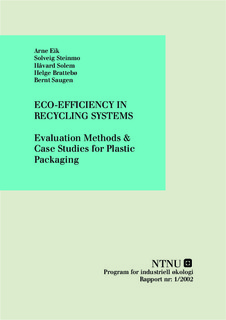| dc.description.abstract | Focus on the so-called waste hierarchy, which claims that the prevention of waste is the most environmental friendly option, followed by reuse, remanufacturing, mechanical recycling, feedstock recycling, energy recovery, incineration and landfill, is considered to be an important strategy towards sustainable development. Increased use of plastic packaging for various products and the corresponding increase in waste generated are important challenges that must be dealt with from a waste-hierarchy point of view.
Many studies, using various methods, have tried to ascertain the extent to which plastic packaging should be recycled into new products, or whether it rather should be incinerated or sent to landfill. However, scientific consensus on this issue has yet to be reached, neither on the use of plastic packaging nor on what method is the most appropriate for answering questions on recycling issues.
The objectives of this study have been to:
1) Develop methods for evaluation of eco-efficiency in recycling systems.
2) Apply these methods to evaluate the eco-efficiency of today’s recycling systems for used plastic packaging from households, identify the improvement potential in these systems, and suggest alternative eco-efficient solutions.
To reach these objectives we have examined the following recycling case studies:
· Source separation system for mixed plastic packaging generated in households in the city of Trondheim, Norway
· Deposit system for one-way PET bottles from inhabitants in Trondheim
We have developed a static and a more dynamic method for evaluation of eco-efficiency in recycling systems, and thereafter applied these methods to the case studies.
The static eco-efficiency method has been developed through an extension of the work done by the World Business Council on Sustainable Development (WBCSD) on eco-efficiency, using the life-cycle method and literature on indicator development. The method is carried out in six steps where the first four focus on evaluating the eco-efficiency of a defined recycling system, while the focus of the last two steps is on identifying the improvement potentials within the recycling systems. Development and implementation of indicators for the various companies in the recycling chain are important parts of this model.
In the dynamic method, two of the developed indicators (% recycling and cost) in the static method are applied in an evaluation of the eco-efficiency of existing and future plastic -packaging recycling systems with a special focus on the production processes and the accompanying cost structure. As the amount of available data is too limited to carry out a valid regression analysis, we have combined the data at hand with theoretical knowledge in order to estimate the relationship between economic costs and various recycling rates.
The eco-efficiency analysis of today’s recycling system of household plastic packaging from Trondheim shows that a great deal of work remains to be done if we are to reduce the costs to a level that will justify the systems, even though we have shown that increased recycling rates give improved environmental performance. If the identified improvement potential is not realized, then incineration with energy recovery, rather than material recovery, may very well be a preferable option for the analyzed system. However, our analysis of possible future recycling systems has shown that recycling of relative large amounts of the plastic packaging generated in households is preferable from an eco-efficiency point of view. To improve the efficiency of recycling systems we have found that efforts should be applied as early as possible in the life cycle of plastic -packaging material. Improved labeling and standardization of packaging, incentives and technology for improved source separation, and production of high-quality recycled products are decisive elements for the eco-efficiency outcome of the future recycling systems.
Further work should be undertaken to refine the applied methods and to test the usefulness of developing and implementing indicators for the activities in the recycling chain aimed at improving the eco-efficiency of the recycling system. Due to the law of mass conservation, it is also important to extend the work on barriers and the improvement potential within the decisive household phase. Since the output in the early stages of the life cycle constrains the end-of-life output, it is important to focus on what kind of incentive and technology is needed to obtain sufficient household sorting rates. To find an answer to this and other issues pointed out in this report, the methodology needs to be developed and is hence a starting point for further studies of eco-efficiency improvements. | nb_NO |
